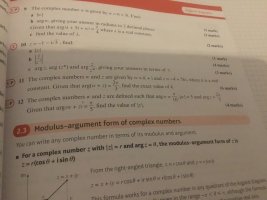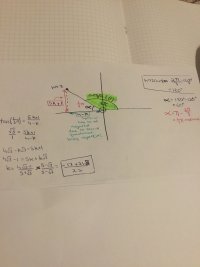Can u do question number 11? It is attached below? I am just a bit puzzled if I use root 3 or minus root3?
whohc one should I use?
My working out….
- w+z =( k-4 )+ (5k+1)i
- 2pi/3= 120 degrees so it is on the left top quadrant.
- argument = 2pi/3. so the right angled triangle will have an angle
60 degrees = pi/3
- since we r in the top left quadrant the adjacent will need to be negative so it will become 4-k.
- soo tan(pi/3) = Opposite / Adjacent.
- soo root3 = 5k+1 / 4-k
= 4root3 - k root 3 = 5k+1
5k+k root 3 = 4 root 3 - 1
k (5 + root 3) = 4 root 3 - 1
k =( 4 root 3 - 1) / (5+ root 3)
Therefore k = (-17 + 21 root 3) / (22)
whohc one should I use?
My working out….
- w+z =( k-4 )+ (5k+1)i
- 2pi/3= 120 degrees so it is on the left top quadrant.
- argument = 2pi/3. so the right angled triangle will have an angle
60 degrees = pi/3
- since we r in the top left quadrant the adjacent will need to be negative so it will become 4-k.
- soo tan(pi/3) = Opposite / Adjacent.
- soo root3 = 5k+1 / 4-k
= 4root3 - k root 3 = 5k+1
5k+k root 3 = 4 root 3 - 1
k (5 + root 3) = 4 root 3 - 1
k =( 4 root 3 - 1) / (5+ root 3)
Therefore k = (-17 + 21 root 3) / (22)
Attachments
Last edited:




